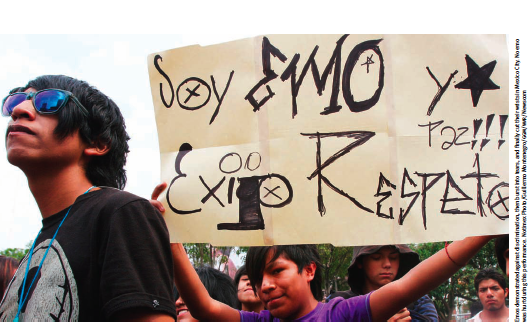Emo Rescue

Emo—a musical subculture defined by melodramatic, sometimes whiny lyrics delivered over distorted guitars—faces a global assault. In Russia the Duma is considering a law to ban emo dress in government buildings. In the U.K. and New Zealand, tabloids blame emo music for teen suicides. And in Mexico, mopey and androgynous emos have been forced to defend themselves against physical attacks. Punks, skaters, skinheads, goths, and the other subcultures that comprise Mexico's tribus urbanas (urban tribes) rioted against the emo kids in March.
The French sociologist Michel Maffesoli created the concept of urban tribes in 1985 to classify metropolitan youths who share a dress code, behavior, and political philosophy. Mexican scholars adopted Maffesoli's criteria as American styles filtered across the border. But some of the academics sound as averse to emo as the rioters in the street. Héctor Castillo Berthier, director of a Mexico City youth culture center, insists that emos don't qualify as an urban tribe because they're too consumerist and lack a social or political philosophy.
The absence of a concrete identity, so infuriating to punks and worrisome to parents, is at the core of emo. What could be easier for a teenager to love-and to hate-than a movement reflecting the confusion of adolescence?
Mike Riggs (mriggs@washingtoncitypaper.com) is City Lights editor at Washington City Paper.
Editor's Note: As of February 29, 2024, commenting privileges on reason.com posts are limited to Reason Plus subscribers. Past commenters are grandfathered in for a temporary period. Subscribe here to preserve your ability to comment. Your Reason Plus subscription also gives you an ad-free version of reason.com, along with full access to the digital edition and archives of Reason magazine. We request that comments be civil and on-topic. We do not moderate or assume any responsibility for comments, which are owned by the readers who post them. Comments do not represent the views of reason.com or Reason Foundation. We reserve the right to delete any comment and ban commenters for any reason at any time. Comments may only be edited within 5 minutes of posting. Report abuses.
Please to post comments


thhfh
thank u
thank you.
http://www.iraqn.com/
http://www.v9f.net/chat
Eh bien, je suis un bon poste watcher vous pouvez dire et je ne donne pas une seule raison de critiquer ou de donner une bonne critique ? un poste. Je lis des blogs de 5 derni?res ann?es et ce blog est vraiment bon cet ?crivain a les capacit?s pour faire avancer les choses i aimerais voir nouveau poste par vous Merci
????? ???
???????